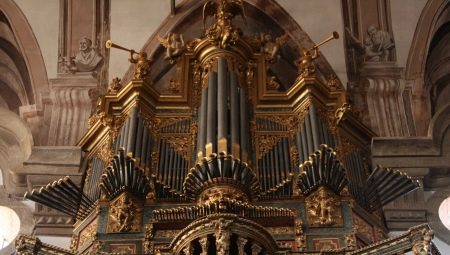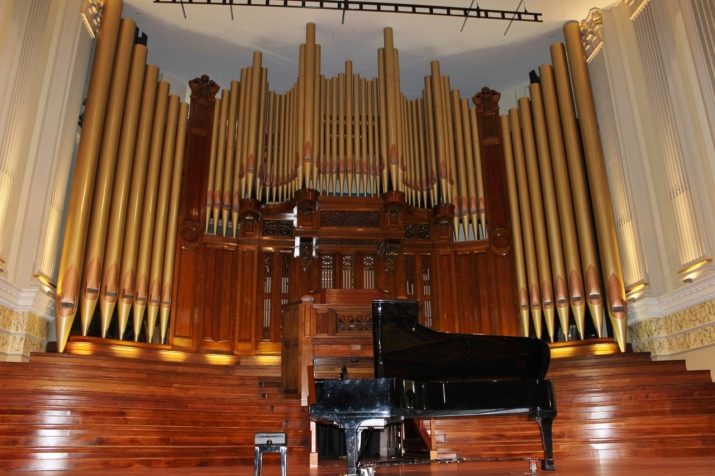What is an organ and what is an instrument like?

The organ is a very peculiar and rather expensive musical instrument that was created a long time ago. About what its history is, what is the principle of its work, what it looks like and not only, we will tell in this article.

Description
The body belongs to the group wind keyboard instruments. Its distinctive feature is gigantic size - its height can be about 15 meters, and its weight can vary around 30 tons.

It is worth mentioning how this musical instrument works. Its structure is distinguished by a certain complexity, because the organ consists of different parts. In general, speaking about the structure of an organ, a number of its main components are distinguished.
- One of the main parts of this tool is lectern or console - this is the name of the part where the place for the performer is located. There he can control the tool using levers, switches and buttons.

- In the same area there are manuals and foot pedals, which are also among the main parts of the structure. Manuals are several keyboards that are intended for manual play. Their number may vary depending on the characteristics of the instrument. As a rule, the number of keyboards does not exceed 7 pieces, but the most common are models with 2-4 manuals. They each have their own registers.

However, among all the manuals, the main one stands out, which is located closer to the performer. Its registers are usually very loud.
- The organ itself has registers - this is how pipes are called, which are united by a similar timbre.To turn on a specific register, the performer needs to perform some manipulations with the lever or the remote control, otherwise the registers will not sound. But it is impossible to say for sure about their number in the organ. This musical instrument has a different number of registers in different countries.


- Organ pipes differ from each other in length, diameter and shape., however, they are all made, as a rule, either from metal or from wood. In some of them you can see the reeds, in others not. Organ pipes are capable of sounding both heavy and low, and high. Their number in a musical instrument can vary and reach 10,000 pieces.

- It is also important for the body pedal keyboardwhich appears to be the foot keys. With their help, the musician can extract low sounds from the instrument.

- There is also such a part in the organ as tractura... This is a whole system of devices that is capable of transmitting a signal from manuals and pedals to pipes and more. At the same time, different types of tractura are distinguished, namely mechanical, pneumatic, electrical and mixed.

History
The organ is rightfully called the king of music. This title is quite justified, because this instrument is distinguished not only by its gigantic size, but also by its age. Its history spans thousands of years, because the organ was created by man even before our era.

In general, it is believed that this musical instrument was "born" from the tandem of the bagpipes or panflute. The original version of the organ worked thanks to a hydraulic pressure device - this device was invented by a craftsman from Ancient Greece, whose name was Ctesibius. It happened back in the II century BC. Subsequently, this musical instrument began to be actively used.

It should be noted that at that time the organs looked very cumbersome. Their keys were thick, creating some inconvenience for the performer, and located at a certain distance from each other, which made playing with the fingers simply impossible. For this reason, medieval musicians actively used their elbows and fists for playing, striking the keys with them.

A special heyday for this instrument happened in the 7th century BC - it was during this period that the church became interested in him. This is easily explained: all the sounds that the organ was capable of producing were perfect for church services.

Sound
The sound of this music is difficult to confuse with any other sound: its music is powerful, it sounds polyphonic, which impresses and amazes.
If we talk about the note range of the organ, then it is limited to only 5 octaves, but in fact, the instrument has a lot of possibilities in terms of sound. The performer can switch its registers, thus transferring the sounding of notes by 1-2 octaves to one side.

As a result, it turns out that not only traditional low and very high melodies are available to this ancient musical instrument - it is also capable of transmitting natural sounds, birdsong, bell ringing, stone rumbles and more. By the 9th century, it was believed that all the best organ makers worked in Italy, and therefore most of the customers turned to them for the instrument. However, after a while, Italy was displaced by Germany, and by the 11th century, a popular musical instrument was actively produced in almost every European state.
The next heyday of this musical instrument fell on the XIV century. It was at this time that they began to change it: its design was improved, the keys and pedals were reduced, the registers were diversified, and the range was expanded. Already by the 15th century, a small portable organ and a medium-sized organ had been created.
The "Golden Age" for the music of this instrument can rightfully be called the 17th-18th centuries. The organ was improved so much that it could well serve as a replacement for an entire orchestra, because it was capable of producing a huge variety of sounds.

But in the XX century, the organ began to lose its relevance, its era, one might say, came to an end, since it was replaced by small and more convenient devices. Nowadays, organs are used in temples, and sometimes at concerts.

Views
There are different types of organs: wind, strings, hand, keyboard, electronic, digital, reed, concert, church, theater, chamber, classical, baroque and symphonic. They differ in shape, size, device and method of sound production, but they generally work according to the same principle.
So, wind the organ is equipped with keys and pipes, it belongs to the class of aerophones. Symphonic the organ has a number of advantages in terms of sound, it has a wider range and greater register capabilities. But at theatrical the instrument does not have such a great variety in terms of sound. It is only capable of producing piano sounds and some noises.


Application
Despite the noticeably declining popularity of the organ, at the present time playing on it is actively used by Catholics and Protestants at church services. In Russia, however, this musical instrument is most often found as an accompaniment to concerts. Moreover, the organ is used both solo and in combination with other instruments. He is actively involved in ensembles, and sometimes in operas.


Notable performers
For such a musical instrument as the organ, works were written by many composers who were famous in the past and before last centuries. Among these composers are such famous personalities as Bach, Sweelinck, Frescobaldi, Grigny, Shchedrin, Shostakovich, Mendelssohn, Dupre and others.





The largest organs in the world
One of the most gigantic in the world is the organ, which is located in the United States, specifically in the city of Atlantic City. His device includes about thirty thousand pipes. This tool has as many as 455 registers and seven manuals.

Another rather large organ is located in Poland, in Warsaw, namely in the Church of St. Anne... This instrument looks like a real work of art, it can be classified as a monumental one. The pipe size of this organ is about 18 meters.

But it is not recommended to be with him while playing him - this can negatively affect your hearing.
Another organ, majestic in appearance and size, is located in Rome, in the Cathedral of St. John the Baptist. Some of the pipes of this instrument are hidden under the most unique molding, and it itself is decorated with various elements with gilding.

But the largest organ in Russia is located in the Cathedral of Kaliningrad. This cathedral is famous not only for its unique musical instrument, but also for its tomb, one of which was the burial place of Immanuel Kant.









